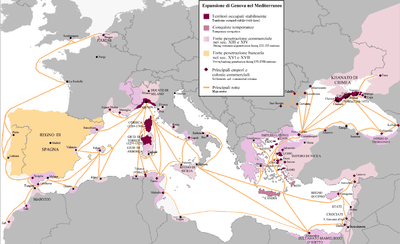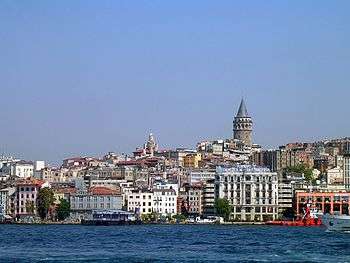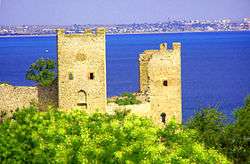Genoese colonies

The colonies of the Republic of Genoa were a series of economic and trade posts in the Mediterranean and Black Seas. Some of them had been established directly under the patronage of the republican authorities to support the economy of the local merchants (especially after privileges obtained during the Crusades), while others originated as feudal possessions of Genoese nobles, or had been founded by powerful private institutions, such as the Bank of Saint George.
History
Genoa, a small, poor fishing village of 4,000 inhabitants, started to become independent from the Holy Roman Empire around 1096, as a free commune. The participation of the city's ships to the Crusades (in particular the conquests of Antiochia and Acre) enriched it enormously. During the First Crusade, Genoa obtained one third of Byblos (which become a familiar possession of the Embriaco family) and Acre (one third of the port's incomes). Other small colonies were formed in Tartous (Syria), Tripoli (Lebanon) and Beirut. However, the Muslim reconquest in the following century removed Genoese presence from the Holy Land. Genoa also established colonies on the Spanish Mediterranean coast from Valencia to Gibraltar, but these were also short-lived.[1] These colonies consisted usually of a city quarter (or even a single square) with wooden single- or double-floor houses with workshops in the lower floor.[2]
Direct territorial expansion of Genoa began in the 13th century with the occupation of Corsica (annexed in 1284 and kept until the 18th century) and northern Sardinia. Genoa remained dominant in the Tyrrhenian Sea after the decisive naval victory against Pisa in the Battle of Meloria (1284). Genoa had also started to form colonies of Ligurians in the Eastern Mediterranean and the Black Sea in second half of the 13th century. The Genoese presence was not based on military occupation, but on economic "concession"s of Genoese and Ligurian families associated with the local traders and dominant classes.[3]
In the eastern Mediterranean, Genoa was greatly advanced by the Treaty of Nymphaeum (1261) with the Byzantine emperor Michael VIII Palaeologus, which, in exchange for the aid to the Byzantine reconquest of Constantinople, actually ousted the Venetians from the straits leading to the Black Sea. The main Genoese commercial bases were Chios and Mytilene in the Aegean Sea, and Caffa, the major trading center between Mongol-ruled Eastern Europe and Central Asia and Western Europe. Other colonies included Cembalo (modern Balaklava), Soldaio (Sudak), Vosporo (Kerch), while other were located on the Azov Sea, including Tana (Azov), Matrega (Taman), Mapa (Anapa), Bata (Novorossijsk) and others, on the Abkhazian coast, such as Savastopoli (Sukhum), or on the Ukrainian coast, such as Salmastro or Moncastro (Bilhorod-Dnistrovskyi), Ginestra (now part of Odessa).[4]

In 1155 Genoa was given a fondaco (store and market quarter) at Galata (Pera), facing Constantinople, by emperor Manuel Komnenos, although in the following century the relationship with the Byzantine Empire were often strained. In 1201 the city also obtained privileges and quarters from the Kingdom of Armenia. Pera fell to the Ottoman forces in 1453, when all of Constantinople was captured. Meanwhile, Chios remained a fief of the Giustiniani family until the Ottoman conquest in 1566.[5] There were some 33,000 descendants of the Genoese colonists in Constantinople and Izmir in 1933.[6] Genoa had also conquered the island of Tabarka off the Tunisian coast, which was held by the Lomellini family from 1540 to 1742. Part of the latter's citizens later moved to Carloforte in Sardinia.
The decline of the Genoese colonies in Crimea coincided with the Ottoman expansion in the late 15th century. Aside from the Crimean cities, Genoa also lost its lands in the Taman Peninsula, which had belonged to the noble Ghisolfi family. Other losses included the commercial bases of Licostomo in Moldavia and Moncastro near Odessa. Some Italian descendants still existed in Crimea in the early 20th century, and were among the ethnic groups suppressed by Joseph Stalin.[7] The fall of the eastern colonies caused a deep economical crisis which eventually turned in an unstoppable decline for the Republic of Genoa as a major European power.[8] While its longtime rival, the Republic of Venice, was able to maintain some continuity between the capital and its eastern possessions, Genoa could not. It thus moved its interests in the western Mediterranean, establishing flourishing communities in Cadiz and Lisbon. Genoa, in particular, became an efficient banking base of Spain.
The last Genoese colonies disappeared in the 18th century: Tabarka was occupied by the Ottoman Empire (1742), and Corsica was annexed by France after the Treaty of Versailles.
See also
References
- ↑ Page at History of Genoa website
- ↑ Structure of the Genoese colonies. Page at www.giustiniani.info (Italian)
- ↑ The first Genoese settlers. Page at imperobizantino.it
- ↑ Genoese colonies in Romania and Moldavia
- ↑ The Turkish possessions of the Giustiani family (Italian)
- ↑ Alessandro Pannuti, "Cenni sugli italiani a Istanbul e la Levantinità
- ↑ The unknown holocaust of the Crimean Italians (Italian) (Russian) (Ukrainian)
- ↑ Ossian De Negri, Teofilo. Storia di Genova.
Bibliography
- Airaldi, Gabriella (2006). Blu come il mare - Guglielmo e la saga degli Embriaci. Genoa: Fratelli Frilli Editori. ISBN 88-7563-174-3.
- Ossian De Negri, Teofilo. Storia di Genova: Mediterraneo, Europa, Atlantico (2003). Florence: Giunti Editore. ISBN 978-88-09-02932-3. Missing or empty
|title=(help) - Lopez, R.S. (1964). "Market Expansion. The Case of Genoa". Journal of Economic History (24).

